A new approach combining deep learning with fluorescence spectroscopy could soon allow food safety checks to happen in real time - offering faster, smarter detection of spoiled or contaminated food from production to plate.

Image Credit: Parilov/Shutterstock.com
Smarter Food Safety with Light and AI
Researchers are exploring how artificial intelligence can complement optical techniques to boost the accuracy and speed of food quality assessments. This method's heart is fluorescence spectroscopy, an optical technique that uses light-emitting molecules to detect chemical properties within food. Paired with deep learning, it holds significant promise for real-world food processing, packaging, and inspection applications.
The Science Behind Fluorescence Spectroscopy
Fluorescence spectroscopy detects the light emitted by certain molecules when excited by ultraviolet (UV) or visible light. It is a well-established tool, but it is tricky to analyze fluorescence signals in real-world food samples. Complex compositions and environmental conditions often distort the signal, producing overlapping patterns and background noise.
Spectral data is also high-dimensional - containing thousands of wavelength-intensity combinations - making it challenging to interpret. While traditional techniques like principal component analysis (PCA) and partial least squares (PLS) have been used, they fall short in handling these datasets' nonlinear and complex nature. That’s where deep learning enters the picture, offering a more adaptive and intelligent approach.
How Deep Learning Enhances Analysis
Combining deep learning with fluorescence spectroscopy requires a careful workflow: data acquisition, preprocessing, model development, and validation.
First, samples are excited with UV or visible light, and the resulting fluorescence is recorded across a range of wavelengths. These emission profiles capture food-specific chemical signatures that signal spoilage or contamination.
Next comes preprocessing - crucial for cleaning up the data. Methods like baseline correction, normalization, and smoothing help reduce noise and highlight meaningful features. Once prepped, this data becomes the input for deep learning models to detect subtle, complex patterns.
Several types of neural networks are used:
-
Convolutional Neural Networks (CNNs) excel at identifying local patterns like spectral peaks.
-
Long Short-Term Memory (LSTM) networks are ideal for handling sequences or time-dependent changes in spectral data.
-
Autoencoders (AEs) assist with unsupervised learning, data denoising, and dimensionality reduction.
To train these models, researchers pair spectral data with known food safety labels - such as “fresh” or “spoiled.” The algorithms are optimized using standard methods like backpropagation, and data augmentation techniques (like adding synthetic noise) help improve generalizability, especially when real-world datasets are limited.
Results That Point to Real-World Potential
The application of deep learning to spectral data has already shown strong results. CNNs have outperformed traditional methods in classifying food by freshness or safety, especially in cases where spectral signals are heavily overlapped or nonlinear.
LSTM models shine in dynamic settings - such as when food fluorescence changes over time or under varying storage conditions. Meanwhile, autoencoders have proven valuable for enhancing signal clarity, ultimately improving downstream classification accuracy.
The choice of excitation wavelength plays a key role in performance. Different fluorophores (light-sensitive molecules) respond to different parts of the UV-visible spectrum. Targeting specific molecules - such as aromatic compounds or proteins - with optimized light sources improves sensitivity and specificity.
While the high dimensionality of fluorescence data is computationally demanding, deep learning algorithms are capable of automatically extracting the most relevant features, removing much of the manual guesswork traditionally required. Importantly, this technology has shown effectiveness across a wide range of foods - from fresh produce to processed items - underscoring its versatility.
What’s Next?
Integrating deep learning with fluorescence spectroscopy makes it possible to design real-time, non-destructive, and scalable food safety systems. These models enhance detection speed and accuracy and reduce costs and human error.
However, a few hurdles remain. Models must become more generalizable across various food types and conditions, and improving interpretability will be key to earning trust from regulators and industry stakeholders. Future research should aim to grow the size and diversity of spectral datasets, refine optical systems for broader applications, and incorporate explainable AI tools to clarify how decisions are made.
Journal Reference
Yuan Y., Zengtao J. et al. (2025). Deep learning-assisted fluorescence spectroscopy for food quality and safety analysis, Trends in Food Science & Technology, Vol. 156, 104821. DOI: 10.1016/j.tifs.2024.104821, https://doi.org/10.1016/j.tifs.2024.104821